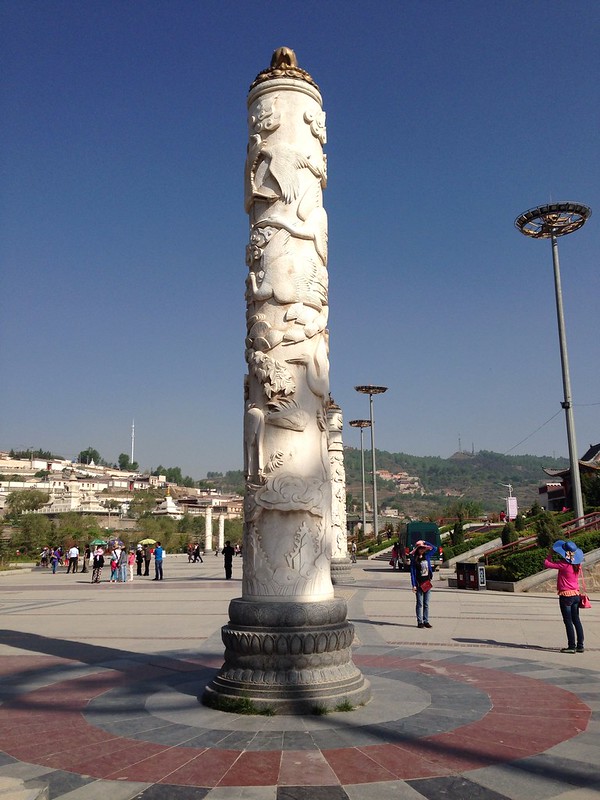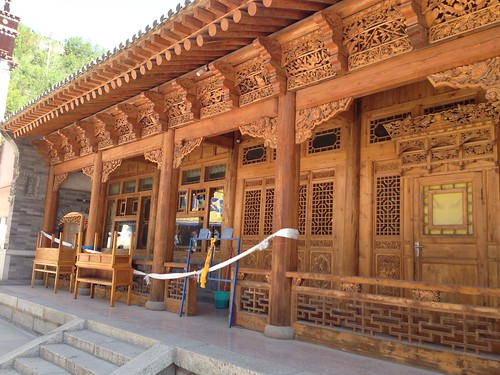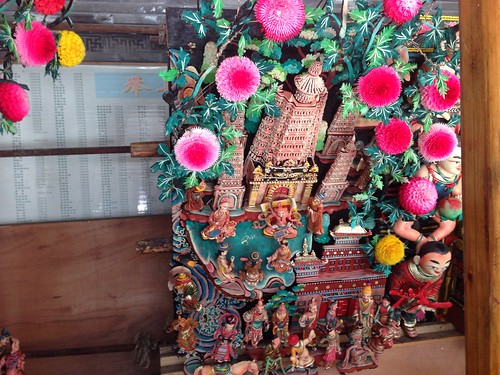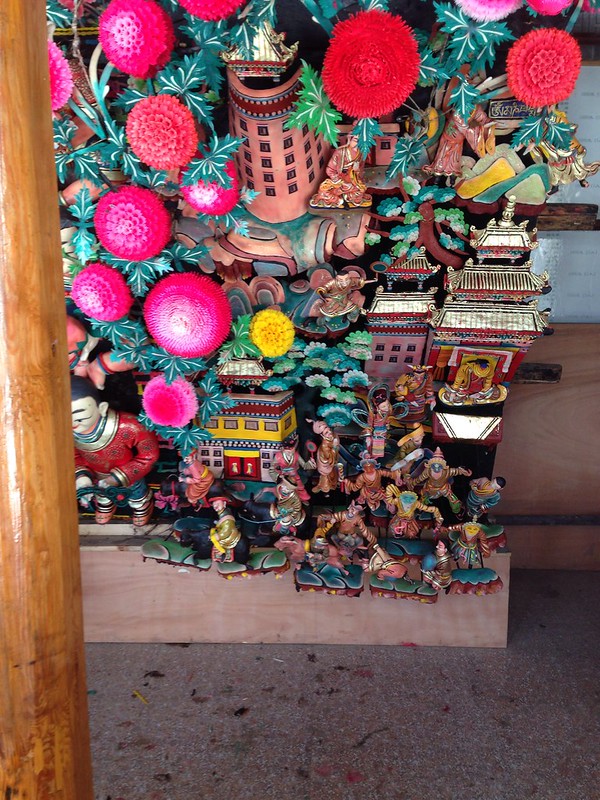I was a little nervous about Xining as it seemed way out there. I didn't doubt for a minute that it was a lovely city located in beautiful scenery. I was worried about what we'd get to eat, what the bathrooms would be like, and where we would sleep. I am quite adventurous when it comes to seeing places but I have two non-negotiables: clean bathrooms and beds. The food is usually the least of my worries, but I came back from the Yangtze River cruise with a bad case of food poisoining. It lasted 4 days before I went to the doctor and got antibiotics. I didn't want a repeat of that experience, especially at the beginning of a trip. So we packed a ton of food - ready to eat meals that needed heating, Indian travel food (a type of chapatti that keeps for days and can be eaten at room temperature), snacks - which weighed down our suitcases. I also had packed for every medical issue - from skin rashes to colds and stomach upsets. I usually travel light and this was the opposite. It was Boy Scout packing - be prepared for every eventuality.
The hotel in Xining was OK. Clean but barely so. The bathroom was clean and functional but there was a moldy bath mat in the corner and the shower grout had mold on it also. The bed was hard with a pillow that felt as if it was stuffed with straw. It was labeled a 4-star hotel but I would have rated it about a 2. Anyway, it satisfied our needs and we were only there one night.
The next morning we headed out to the Kumbum monastery. It is the birthplace of TsongKhaPa, the founder of the Gelugpa or Yellow hat sect of Tibetan Buddhism. He was the teacher of the first Dalai Lama, who is the head of the sect. It is about an hour drive from Xining.
The monastery is gorgeous. I can't show you most of it because we couldn't take photos inside. I recommend you do a search for images of the monastery and you'll see how rich and colorful it is. It is set on a hillside
There are vendors at the entrance selling all sorts of tourist kitsch. Fake Tibetan dresses - more Mongolian than Tibetan, I think - and the ever present beads and prayer necklaces.

Looking back at the entry plaza from the gate, you can see the hills and the buildings around the monastery. There are pillars in the entry plaza. I'm not sure what they mean. The guide couldn't explain either.
We bought our tickets and headed in. The first thing you see is this set of chorten. Apparently this is the only monastery with 6 in a row.
Then there are the golden roofs.
This is the small golden roof. The larger one is over the building that houses the tree where TsongKhaPa was born. Tibetan architecture involves a type of wood that allows buildings to breathe. We saw more of this in the Potala Palace. It is the section between the windows that is made of this wood.
We saw a lot of worshippers prostrating themselves. They take a vow to do 100,000 prostrations if something they want happens. They arrange to stay in the vicinity for weeks or months and spend the entire day prostrating themselves. There were a large number of them at Kumbum. It was impressive to see so many people exhibit such intense devotion.
We came out into this central courtyard after going through the various shrines. The building you see is the outside of one of them.
This is another view from the same courtyard but one that shows the golden roofs of the shrines better.
There was a lot of going up slopes as we walked through the monastery. It was tough. Xining is not as high as Lhasa but it is still higher than sea-level and we were slow and got out of breath fast. People recommend staying 3-4 days at Xining to make adjustment to Lhasa easier. But we only spent a day there and then a day on the train.
After walking through the monastery, we went to the library. The set of buildings around the library included this gorgeous carved wooden one.
Just on the other side of this building is a climate controlled one that contains the famous yak butter sculpture. The monastery is known for this. The monks make the sculpture in the winter, mixing mineral colors with yak butter to make the sculpture. It is then kept in this cool building all year.
Yes, all that is sculpted out of yak butter. One of the things we learned was that there are two kinds of yak butter. One is not actually yak butter, it sounded as if it was made from palm oil, and is used for the lamps in the temples. The other is yak butter and is consumed in tea and other consumables. Many worshippers bring bags of the 'yak butter' and spoon it into the lamps as they go through the shrines. This variety comes in plastic bags. Some people also bring it in melted form in thermoses to the temples. I never saw the consumable one in raw form.
Once we were done with the monastery, we drove back to Xining and had lunch. Then we had 2-3 hours to kill till our train. The guide could have taken us to some other place in Xining - it is supposed to have a lovely mosque - but she didn't. We weren't prepared with our guide book so we didn't know to ask. We hung out at a coffee shop till it was time to head to the train.
At the train station, we had a l-o-n-g walk from the car to the station. It was hot (mid-day) and sunny and we were hauling our suitcase. We only had one carry-on sized suitcase and a bag for each of us and the suitcases rolled. But it was still work to drag them to the station. Once inside, we got to sit in a special waiting room for people with tickets to the soft sleeper section of the train. I wanted to go to the platform early but the attendant at the waiting room wouldn't let me. This train station is a temporary train station as they are rebuilding Xining's train station. The new one will open next year.
When it was time, she finally let us go. But, as I had feared, we had to climb up a set of steps to the platform. Because of its temporary nature, there weren't any escalators. Yup. altitude, stairs and suitcases. Not a good combination. Plus, the train was already there and we knew we had to find our coaches before it left. So we hauled everything up the stairs and found ourselves at the tail end of the train. Our tickets said we were in coach +1. We were at coach 14. Yikes!
We hustled up the length of the train, feeling as if our hearts were going to jump out of our chests. It was one of the worst physical moments of the trip. We got all the way to the front, stopping periodically to ask where our coach was. Well, we didn't ask often enough. Once we got to the front, we were sent back to about coach 5 or 6. I had been looking for a coach numbered +1 but didn't see it. Completely out of breath and exhausted, we got on and found that our suitcases did not fit under the lower sleeper bench.The only other place was an alcove above the door - above the upper sleeper bench. We did not have the energy to get the suitcases up there. We just collapsed on the lower bench and caught our breath. Our two companions in the compartment did not speak English. One knew a smattering, the other none at all. I used my Mandarin-English dictionary to ask about oxygen masks. The train is supposed to provide them as we go through a pass that is at 16,000+ feet. We never got the masks despite our asking the attendants multiple times.
But that is a story for the next post...
The hotel in Xining was OK. Clean but barely so. The bathroom was clean and functional but there was a moldy bath mat in the corner and the shower grout had mold on it also. The bed was hard with a pillow that felt as if it was stuffed with straw. It was labeled a 4-star hotel but I would have rated it about a 2. Anyway, it satisfied our needs and we were only there one night.
The next morning we headed out to the Kumbum monastery. It is the birthplace of TsongKhaPa, the founder of the Gelugpa or Yellow hat sect of Tibetan Buddhism. He was the teacher of the first Dalai Lama, who is the head of the sect. It is about an hour drive from Xining.
The monastery is gorgeous. I can't show you most of it because we couldn't take photos inside. I recommend you do a search for images of the monastery and you'll see how rich and colorful it is. It is set on a hillside
There are vendors at the entrance selling all sorts of tourist kitsch. Fake Tibetan dresses - more Mongolian than Tibetan, I think - and the ever present beads and prayer necklaces.

Looking back at the entry plaza from the gate, you can see the hills and the buildings around the monastery. There are pillars in the entry plaza. I'm not sure what they mean. The guide couldn't explain either.
We bought our tickets and headed in. The first thing you see is this set of chorten. Apparently this is the only monastery with 6 in a row.
Then there are the golden roofs.
This is the small golden roof. The larger one is over the building that houses the tree where TsongKhaPa was born. Tibetan architecture involves a type of wood that allows buildings to breathe. We saw more of this in the Potala Palace. It is the section between the windows that is made of this wood.
We saw a lot of worshippers prostrating themselves. They take a vow to do 100,000 prostrations if something they want happens. They arrange to stay in the vicinity for weeks or months and spend the entire day prostrating themselves. There were a large number of them at Kumbum. It was impressive to see so many people exhibit such intense devotion.
We came out into this central courtyard after going through the various shrines. The building you see is the outside of one of them.
This is another view from the same courtyard but one that shows the golden roofs of the shrines better.
There was a lot of going up slopes as we walked through the monastery. It was tough. Xining is not as high as Lhasa but it is still higher than sea-level and we were slow and got out of breath fast. People recommend staying 3-4 days at Xining to make adjustment to Lhasa easier. But we only spent a day there and then a day on the train.
After walking through the monastery, we went to the library. The set of buildings around the library included this gorgeous carved wooden one.
Just on the other side of this building is a climate controlled one that contains the famous yak butter sculpture. The monastery is known for this. The monks make the sculpture in the winter, mixing mineral colors with yak butter to make the sculpture. It is then kept in this cool building all year.
Yes, all that is sculpted out of yak butter. One of the things we learned was that there are two kinds of yak butter. One is not actually yak butter, it sounded as if it was made from palm oil, and is used for the lamps in the temples. The other is yak butter and is consumed in tea and other consumables. Many worshippers bring bags of the 'yak butter' and spoon it into the lamps as they go through the shrines. This variety comes in plastic bags. Some people also bring it in melted form in thermoses to the temples. I never saw the consumable one in raw form.
Once we were done with the monastery, we drove back to Xining and had lunch. Then we had 2-3 hours to kill till our train. The guide could have taken us to some other place in Xining - it is supposed to have a lovely mosque - but she didn't. We weren't prepared with our guide book so we didn't know to ask. We hung out at a coffee shop till it was time to head to the train.
At the train station, we had a l-o-n-g walk from the car to the station. It was hot (mid-day) and sunny and we were hauling our suitcase. We only had one carry-on sized suitcase and a bag for each of us and the suitcases rolled. But it was still work to drag them to the station. Once inside, we got to sit in a special waiting room for people with tickets to the soft sleeper section of the train. I wanted to go to the platform early but the attendant at the waiting room wouldn't let me. This train station is a temporary train station as they are rebuilding Xining's train station. The new one will open next year.
When it was time, she finally let us go. But, as I had feared, we had to climb up a set of steps to the platform. Because of its temporary nature, there weren't any escalators. Yup. altitude, stairs and suitcases. Not a good combination. Plus, the train was already there and we knew we had to find our coaches before it left. So we hauled everything up the stairs and found ourselves at the tail end of the train. Our tickets said we were in coach +1. We were at coach 14. Yikes!
We hustled up the length of the train, feeling as if our hearts were going to jump out of our chests. It was one of the worst physical moments of the trip. We got all the way to the front, stopping periodically to ask where our coach was. Well, we didn't ask often enough. Once we got to the front, we were sent back to about coach 5 or 6. I had been looking for a coach numbered +1 but didn't see it. Completely out of breath and exhausted, we got on and found that our suitcases did not fit under the lower sleeper bench.The only other place was an alcove above the door - above the upper sleeper bench. We did not have the energy to get the suitcases up there. We just collapsed on the lower bench and caught our breath. Our two companions in the compartment did not speak English. One knew a smattering, the other none at all. I used my Mandarin-English dictionary to ask about oxygen masks. The train is supposed to provide them as we go through a pass that is at 16,000+ feet. We never got the masks despite our asking the attendants multiple times.
But that is a story for the next post...









No comments:
Post a Comment